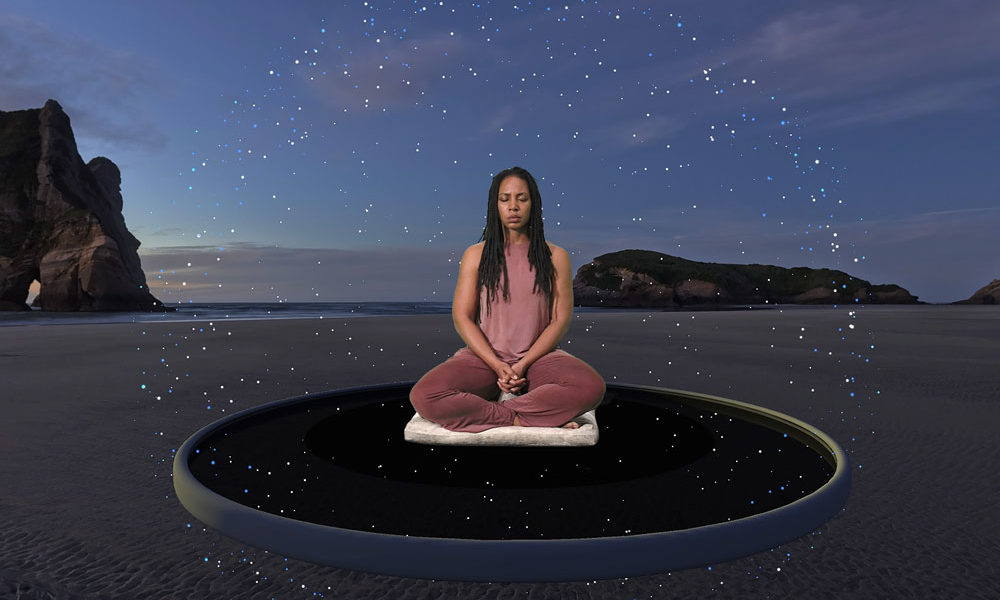I tell myself, it doesn’t matter. Tomorrow when I wake up, this will seem small. That someone, that something, that no one, that nothing, none of it has a long-term effect on my life. Yet, I have no idea why my mind wakes me up, thinking frantically at 3:30 in the morning. As my mind goes back and forth arguing with itself — you need to solve this right now, no you don’t — I wonder why I can’t chill out.
This all takes me back to my first-ever yoga class, when the instructor asked me to bring my thoughts into “the present moment.” Turns out, that skill isn’t just for better meditation and yoga practices. It’s good for sleep, focus, stress relief and big picture thinking. Stephanie Kersta, MSc, RP, is a co-founder of Hoame, a meditation studio in Toronto, tells me that the inability to stop thoughts can be a symptom of anxiety. And “oftentimes, it is a way for us to ‘control’ a situation, what therapists call a ‘safety behaviour.’ ”
The stressed-out newbie’s guide to meditation.
How overthinking affects the brain – and the body
First, recognize that a ruminating brain is signalling stress. Not just emotionally, but physically, too. Habits – like skipping meals, staring at blue light for too long, muscles not relaxed, overly tired, and so on – can also trigger active thoughts.
“The body and brain are interconnected, so if our bodies feel stressed — overtired, hungry, tense — our brain is impacted,” says Kersta. “The same for the reverse. When we are worried about something, our body often will be tense, or we will see it in the form of headaches, GI upset, or heart palpitations.” (GI = gastrointestinal).
Plus, all of this thinking goes deeper, according to Kersta. “Rumination is a symptom of stress and anxiety, which causes inflammation in the body. Inflammation has been linked to every health issue we know. Additionally, stress and anxiety can manifest in the body in the form of sleep, cardiac, musculatory, circulatory and digestive issues.”
Great! More guilt to hang over us, right?
Nope. It’s time to break the cycle. And Kersta confirms it can be done.
“Overthinking can feel overwhelming, and it can feel like you will never be able to break the cycle,” she says, noting that teaching yourself to calm the mind and the body with meditation is where to start. “But the good news is that [it] works really well, so stick with it and you will feel better.”
Kylie Jenner ASMR & sound baths: Is sound a meditation cheat code?
How to hit pause on raging thoughts
If you’ve tried everything but your mind continues to race, be gentle on yourself. Meditation can be hard. “For clients struggling to meditate, I often recommend changing up the style of meditation, posture and [how long] they are meditating for, to start,” says Kersta. “It often isn’t that they can’t meditate, but rather that they haven’t found what works for them.”
Variety is the spice of life – or rather the sedative!
Start off with a three-minute meditation program, and choose a time when you find your mind is “quiet,” she says. That could be first thing in the morning or after lunch, whenever you are your most relaxed. Just make sure you’re comfortable. And choose a guided meditation, instead of trying to do it yourself in silence. Once you do this often enough, you can flip the meditation switch more effectively, like when something is bugging you.
Another option? A grounding mindfulness activity for five to 10 minutes, says Kersta. That can be going for a walk, listing the things you see and smell.
Kersta also recommends downloading a meditation app, like Hoame’s new meditation program for Meta Quest. (That’s, the virtual reality space accessed with those headsets you’ve seen on TikTok.) “It transports you to an immersive in-studio class. And it provides a visual cue to anyone that you live with that you are meditating. I’ve been interrupted one too many times in my space, so I really value this.”
One small step for anxiety: Living proof walking can impact your mental health.
Creating a meditation room at home
You can meditate anywhere you’re able to. But with Pinterest trends showing a rise in at-home self-care room searches, I get Kersta’s tips on ensuring my at-home gym is also meditation-friendly. She says to There are props you can add to the space, including a sit set, yoga mat, blankets and cushions, essential oils, crystals and mala beads. “I recommend starting off with less, as you can add to it as your practice builds.”
The Pinterest pins we’ll all be pinning for fitness and health ideas.
Relaxing my active brain at night
Ruminating leads into a cycle of me arguing with myself, apparently. Kersta says this is a natural defence mechanism to overanalyze to “fix” something, so as to not be caught off-guard later. But this will amplify my thoughts even more. “Often those highly emotional thoughts that represent our true fears are the ones that tend to activate the spiral the most.”
I’ve also changed a few things in my bedtime routine. I’ve stopped looking at my cell at night time (does sleep mode even do anything?) and I invested in an amber reading light to get back to reading new books!
I also brought my half-moon meditation pillow into the bedroom to position myself to tackle those never-ending thoughts. As for my grounding exercise, I’ve started to identify the sensations of my muscles from head to toe, relaxing my forehead and jaw, to unclenching my hands and wiggling my toes. And a lavender pillow spritz helps, too. I take a few deep breaths, focusing on those feelings, and have a meditation playing on my phone. Next thing I know it’s morning.

